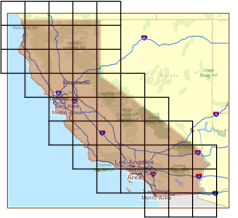The web layer's estimated cache size may result in a significant amount of tile generation time as well as storage.
Solution
- Do nothing.
- If you do not want to share a large cached web layer, you can use a number of caching strategies to reduce the size of the cache. These include reducing the level of detail, using a feature class to define an area of interest in which to create tiles, changing the tile format, using on-demand caching for less-viewed areas, and reducing the visible scale ranges of the cache. You can use these individually or in combination.
More information
Web tile layer caches can take a lot of server resources to create and store. There are a number of things you can do to reduce the overall size of your cache.
- When choosing the scale levels for your cache, remember that the closer you zoom in on the map, the more tiles are required to cover the map extent, and the longer it will take your cache to generate. Every time you halve the scale's denominator, it takes four times as many tiles to cover a square area of the map. For example, a square map at 1:500 scale contains four times more tiles than a map at 1:1,000 scale, and a square map at 1:250 contains 16 times more tiles than a map at 1:1,000 scale.
- Caching by feature class boundary allows you to create tiles only in the places where you need them, avoiding empty or uninteresting areas. For example, if you are caching a country, you might supply a feature class of major urban areas. By doing so, you are requesting that the server only precreate tiles that cover those urban areas. The rest of the areas can be cached on demand when requested by clients. This can save you time and disk space that would be consumed by creating unneeded tiles in rural areas. The image below shows a theoretical grid of tiles that would be created if the feature class contained just the state of California. Unneeded tiles in the ocean and in neighboring states are not created. These unneeded tiles would have been included if the default rectangular extent had been used.

- On-demand caching is the act of creating tiles the first time they are requested by a client instead of precreating the tiles. On-demand caching is a good way to save space and cache creation time, but the first person who navigates to the map area has to wait for the tiles to be drawn. Commonly viewed areas can have tiles precreated and the tiles for less-viewed areas are created on demand.
When used wisely, on-demand caching can save you much time and disk space. Most maps show some area that is barren, unusable, or uninteresting to the map audience, especially at large scales (zoomed in). Caching on demand relieves you of the burden of creating and storing these unneeded tiles but leaves the possibility that a user could still view the area if needed.
Caution:
Although on-demand caching is a useful feature, it can put an unnecessary strain on performance when misused or overused. When overused, caching on demand can consume available disk space on the cache drive. The administrator should constantly verify the availability of disk space for such services.